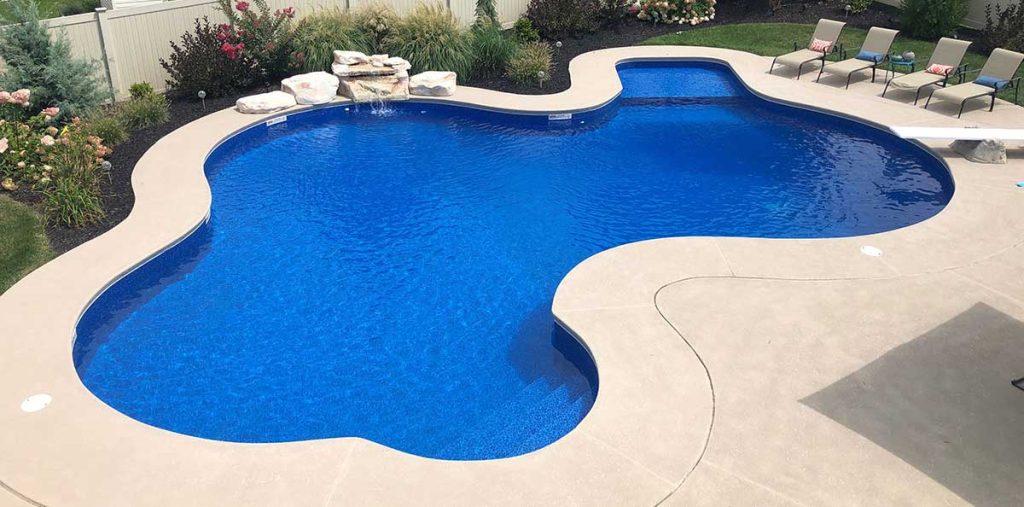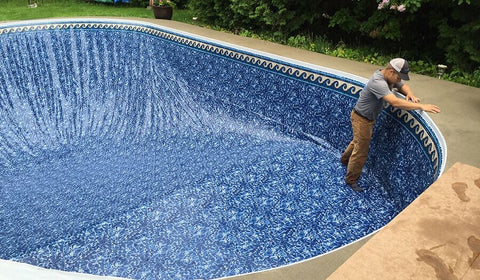
Vinyl Pool Liners' Lifespan, Patching, and Repair
There are many advantages to having an in-ground pool with a vinyl liner. Vinyl swimming pool liners are less expensive than concrete pools. They are also easier to maintain than concrete. Vinyl pool liners are very durable. If they are maintained properly, a good vinyl pool liner can last up to 10 years before need to be replaced.
If you are considering installing an in-ground swimming pool in your backyard, vinyl pools are relatively quick to install compared to concrete pools. A vinyl lined pool can be installed in as little as 5 - 6 weeks while a concrete pool installation can take up to 6 months to build. Perhaps one of the most compelling arguments for vinyl pools are the customization options. With vinyl, design options, shapes and size, can be customized in many ways.
As you probably already know, vinyl in the most common liner material for above ground pools.
How Long Does A Vinyl Swimming Pool Liner Last

Vinyl liners in in-ground pools can last as long as 10 years if taken care of. Vinyl liners in above ground pools can last 15 years! The key to vinyl pool liner longevity is the care of the pool owner. There are many factors that damage a vinyl liner and shorten it's lifetime.
The UV radiation of sunlight might be the most damaging factor for a vinyl liner. Sunlight will eventually fade your liner. This process can be slowed down if you cover your pool during the off season. However, if you live in a tropical climate like southern Florida, your liner will begin to fade from solar exposure around year 5 or 6. In most cases, this fading is cosmetic and won't effect the performance of the liner. Sunlight can cause a drying out of you vinyl liner, especially the above water portions.
Chemicals in your pool water can also damage your pool liner. Chlorine in particular can be hard on vinyl liners. Keep you chlorine levels around 3 parts-per-million (ppm) to extend the life of you liner. Over chlorination will cause your liner to fade prematurely and become brittle and prone to tearing.
Swimming pool tools can also damage vinyl liners. If you have a vinyl liner, make sure you are using a nylon bristled pool brush to clean the pool surfaces. Steel bristle pool brushes are manufactured for concrete swimming pools. Steel brushes can weaken and tear your vinyl pool liner.
Can You Patch A Hole or Tear In A Vinyl Liner

Yes, you can definitely patch a hole of tear in a vinyl pool liner. Eventually every pool owner will have to deal with repairing or replacing their liner. In fact, patching your vinyl liner is far easier and cheaper than replacing your liner, above-ground and in-ground.
There are a few good ways to repair your liner. Options include vinyl repair tape products, vinyl repair patch kits, epoxy kits, or simple peel and stick patches. Assessing the type of damage your pool liner has will help you decide which option to use.
Vinyl repair tape can be applied easily, quickly, and temporarily. Tape repair is a great way to stop a small leak but repair tape is not designed to last and will need to be replaced.
Epoxy repair kits are perfect for small cracks in you vinyl liner caused by drying and UV damage. The epoxy product will fill small cracks sealing them very quickly. Epoxy repair is a good, long-lasting option for small, thin cracks.
Vinyl repair patch kits are designed for holes, punctures, and gashes. A vinyl patch can be cut to size. Holes above the pool water line can be sealed simply by cutting the patch, generously adding the adhesive and placing the patch. If the damage point is below the water line, You will need to cut your patch, apply the adhesive and dive to the breech and apply the patch under water. Vinyl repair patch kits are designed to be used underwater. You might want to wear a mask to make sure you have accurate patch placement. You should never drain the water in a vinyl lined pool, in ground or above ground. Your pool's vinyl liner needs the weight and pressure of the water to keep it smooth and tight. Draining pool water will cause your liner to draw up creating wrinkles which are difficult to make smooth again. Avoid draining your water at all costs!
All of these concepts apply to both above ground and in ground pools.
How Do You Know When to Replace Your Liner

Over time pool chemicals, sunlight, and user wear-and-tear will damage your pool's liner. Eventually, your pool liner will need to be replaced. As your pool liner ages you will notice fading and maybe staining. This is the first stage of liner deterioration. Over time tiny cracks will begin to form in your liner. As mentioned, these can be repaired to extend the life of a liner but replacement will become necessary.
You may begin to detect some wrinkling on the vinyl of your pool walls and bottom. This is an indication that the liner should be replaced. Wrinkling is caused by your liner contracting. As the vinyl ages, it loses some of its elasticity causing it to draw up creating wrinkles.
Leaking is another indicator of a vinyl liner aging. Leaks can be patched but patches are temporary. If you find yourself regularly parching holes in your liner, you may want to consider installing a brand new liner.
All pool surfaces have pros and cons. Vinyl liners are great because they are durable, economical, and easier to repair that concrete, fiberglass or gunite. The life of a vinyl liner can be extended with care and patching. Be good to your pool liner and it will be good to you.
You May Also Like
Pool Shock - Everything You Need to Know
Considering An Above Ground Pool In 2024
- Intro
- How long does a vinyl pool liner last
- What damages your pool liner
- Do you have to drain the water
- Can you patch a tear in your pool liner
- What about AB pools
- How do you know when your pool liner needs to be replaced
- Wrap
